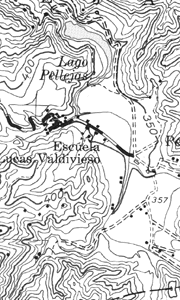
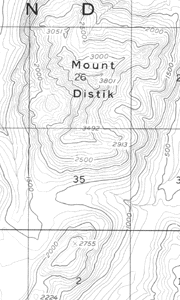
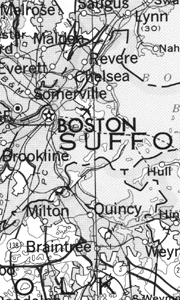
 |
 |
 |
| 1:20,000-scale map | 1:63,360-scale map | 1:500,000-scale map |
The proportion chosen for a particular map is its scale. Selecting the appropriate scale depends on the size of the sheet of paper and the accurate placement of features. Ground area, rivers, lakes, roads, distances between features, and so on must be shown proportionately smaller than they really are.
| Top |
These "representative fraction" scales mean that 1 unit of measurement on the map—1 inch or 1 centimeter—represents 10,000 of the same units on the ground. If the scale were 1:63,360, for instance, then 1 inch on the map would represent 63,360 inches, or 1 mile, on the ground (63,360 inches divided by 12 inches equals 5,280 feet, or 1 mile). The first number (map distance) is always 1. The second number (ground distance) is different for each scale; the larger the second number is, the smaller the scale of the map. "The larger the number, the smaller the scale" sounds confusing, but it is easy to understand. A map of an area 100 miles long by 100 miles wide drawn at a scale of 1:63,360 would be more than 8 feet square. To make the map a more convenient size, either the scale used or the area covered must be reduced.
If the scale is reduced to 1:316,800, then 1 inch on the map represents 5 miles on the ground, and an area 100 miles square can be mapped on a sheet less than 2 feet square (100 miles at 5 miles to the inch equals 20 inches, or 1.66 feet). On the other hand, if the original 1:63,360 scale is used but the mapped area is reduced to 20 miles square, the resulting map will also be less than 2 feet square.
Such maps would be easier to handle. But would they be more useful? In the small-scale map (1:316,800), there is less room; therefore, everything must be drawn smaller, and some small streams, roads, and landmarks must be left out altogether. On the other hand, the larger scale map (1:63,360) permits more detail but covers much less ground.
Many areas have been mapped at different scales. The most important consideration in choosing a map is its intended use. A town engineer, for instance, may need a very detailed map to locate precise sewers, power and water lines, and streets. A commonly used scale for this purpose is 1:600 (1 inch on the map represents 50 feet on the ground). This scale is so large that many features—such as buildings, roads, and railroad tracks—can be drawn to scale instead of being represented by symbols.
| Top | Main Table of Contents
|
Maps at 1:24,000 scale are fairly large and provide detailed information about the features of an area, including the locations of important buildings and most campgrounds, ski lifts, and water mills. Footbridges, drawbridges, fence lines, and private roads are also shown at this scale. Usually these features are omitted from maps in the 1:50,000- to 1:100,000-scale range; these maps cover more area while retaining a reasonable level of detail. Maps at these scales are most often produced using the 30- by 60-minute quadrangle formats.
Small-scale maps (1:250,000 and smaller) show large areas on single map sheets, but details are limited to major features, such as boundaries, parks, airports, major roads, railroads, and streams.
| Top | Main Table of Contents
|
For additional information, visit the USGS home page at
www.usgs.gov.
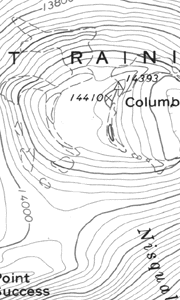 |
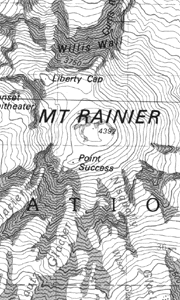 |
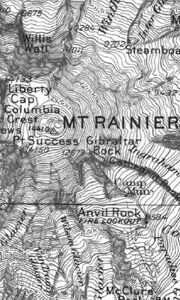 |
| 1:24,000-scale map | 1:100,000-scale map | 1:250,000-scale map |
| Series | Scale | 1 inch represents
approximately |
1 centimeter
represents |
Standard quadrangle size
(latitude by longitude) |
Quadrangle area
(square miles) |
|---|---|---|---|---|---|
| Puerto Rico 7.5 minute | 1:20,000 | 1,667 feet | 200 meters | 7.5 by 7.5 minute | 71 |
| 7.5 minute | 1:24,000 | 2,000 feet (exact) | 240 meters | 7.5 by 7.5 minute | 49 to 70 |
| 7.5 minute | 1:25,000 | 2,083 feet | 250 meters | 7.5 by 7.5 minute | 49 to 70 |
| 7.5 by 15 minute | 1:25,000 | 2,083 feet | 250 meters | 7.5 by 15 minute | 98 to 140 |
| USGS-DMA 15 minute | 1:50,000 | 4,166 feet | 500 meters | 15 by 15 minute | 197 to 282 |
| 15 minute* | 1:62,500 | 1 mile | 625 meters | 15 by 15 minute | 197 to 282 |
| Alaska Maps | 1:63,360 | 1 mile (exact) | 633.6 meters | 15 by 20 to 36 minute | 207 to 281 |
| County Maps | 1:50,000 | 4,166 feet | 500 meters | County area | Varies |
| County Maps | 1:100,000 | 1.6 miles | 1 kilometer | County area | Varies |
| 30 by 60 minute | 1:100,000 | 1.6 miles | 1 kilometer | 30 by 60 minute | 1,568 to 2,240 |
| 30 minute* | 1:125,000 | 2 miles | 1.25 kilometers | 30 by 30 minute | 786 to 1,124 |
| 1 degree by 2 or 3 deg | 1:250,000 | 4 miles | 2.5 kilometers | 1° by 2° or 3° | 4,580 to 8,669 |
| State Maps | 1:500,000 | 8 miles | 5 kilometers | State area | Varies |
| State Maps | 1:1,000,000 | 16 miles | 10 kilometers | State area | Varies |
| U.S. Sectional Maps | 1:2,000,000 | 32 miles | 20 kilometers | State groups | Varies |
| Antarctica Maps | 1:250,000 | 4 miles | 2.5 kilometers | 1° by 3° to 15° | 4,089 to 8,336 |
| Antarctica Maps | 1:500,000 | 8 miles | 5 kilometers | 2° by 7.5° | 28,174 to 30,462 |